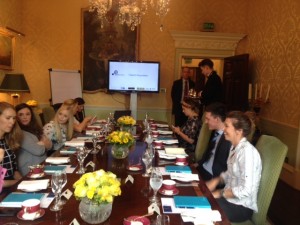The event
We held our first ever Fashion Roundtable at The Ritz on Thursday 16th October with a number of our fashion clients to discuss the issues that matter to them about search marketing. Whilst enjoying champagne afternoon tea in the grand setting, the main topic of discussion was the ever-changing environment of SEO.
Getting other internal teams excited about SEO can be difficult. And when SEO now needs to include buy-in from the Content, Social and PR teams to make a successful campaign, large companies are finding this a challenge across the board.
Working with the PR team
A recurring theme from the discussion was internal PR teams having a blogger ‘blacklist’ that means the SEO team have a limited number of quality bloggers that they can utilise. The blacklists consisted of highly influential bloggers that have existing relationships with these internal PR teams. In some instances all contacts have to be sent to the PR team who will indicate whether the SEO team is allowed to contact them before any outreach can commence.
One suggestion put forward as to how they have tried to combat this, is by getting the PR team involved in SEO projects. They can then work together and the end results will be beneficial for both departments and ultimately mean that rather than a few poor quality links, 10-15 with a much higher domain authorities can be achieved.
An open-ended question that was raised centered on whether the brands PR departments know the value of a link. If not, then a simple yet effective way to engage them in SEO is to educate them on the value links can bring to your website and business as a whole. If this is something you would not feel comfortable doing, or you think third party advice would be more effective, Search Laboratory would be happy to help you with this.
Continuing in this vein, it was also apparent that many traditional PR teams, who tend to be more store than online-focused, still see SEO as a spam-ridden industry and contacting influential bloggers could be damaging to the brands reputation. As everyone at the Fashion Roundtable was aware, this is a very outdated view of the industry and one that can be detrimental to relationships internally.
One company present engaged their PR team in their SEO efforts by looking at what PR want and giving them just that. Brand exposure is the PR teams ultimate goal and by showing them the online coverage that the SEO team is building along with organic traffic and revenue, they were much more responsive to change and cooperation. A two hour workshop session with the PR team introduced these principles and now both teams work alongside each other more effectively.
The physical separation of these departments in office buildings has also caused issues as this means the teams do not have daily contact with each other. One fashion client has overcome this by physically moving departments around so that all of traditional marketing, PR and online marketing are sat on the same floor in close proximity. By also employing a strong person to connect the commercial director with the brand and creative director, the teams are becoming more joined up.
Branding is a large part of PRs responsibility to the company and as such is keen to ensure that all content and outreach in the company’s’ name is completely on brand. This means they may need final sign-off which can lengthen the process and could also dilute what your target audience is looking for.
Working with the content team
The Content team will more than likely have a content calendar that they work to throughout the year promoting seasonal trends and key pieces. It is important that the SEO team is involved in content from the very beginning so that editorial is keyword rich but not stuffed and influencers could be contacted before its creation to ensure it is what your audience are looking for.
A couple of the companies who attended the Roundtable said that they had experimented with content centered around physical store locations, which were very successful but could have been made more of had all departments internally and third parties been allowed to contribute. Sometimes this type of content is created without any input from the SEO team and had there been, amplification techniques could have been used to ensure that the content gained the coverage it deserved, therefore keeping the Content, PR and SEO teams happy. This is also the case with internal stories that could be used for online PR purposes and high quality link building. For example, alumni stories are easy to create and gain authoritative university and college links.
If this is the case then how do you get an idea pushed through to production?
Many companies are so restricted by brand reputation that to veer from the norm would require the SEO team to be armed with exactly the right data and would have to speak to the right people to do this. The consensus in the room seemed to be that the idea for content can come from any department or from an external source; it just needs buy in from all other departments and have SEO input from the start to make sure that the benefit derived is optimal. A valid point was made that SEO should be the magic dust sprinkled on top of all content and PR activity.
Having a joined-up SEO team that incorporates all aspects of digital marketing (social, content, PR, brand, marketing) really is the key to online PR success. Working together will ultimately return the results needed to boost online visibility. As the discussion from this Roundtable has proved large companies with numerous teams that have input into SEO are finding it hard to get the best out of their campaigns due to these internal complexities but others who have already addressed these issues head on are already seeing the benefits.



